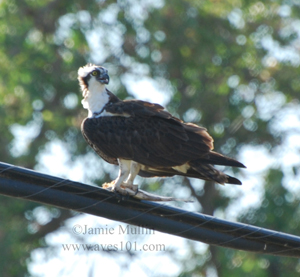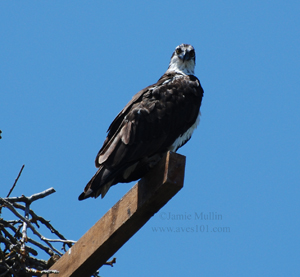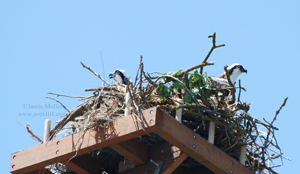Osprey
Order: Falconiformes
Family: Accipitridae
Genus: Pandion
Species: haliaetus
**Osprey Audio Below**
Description
-
Length: 23"
-
Wing span: 63"
-
Weight: 3.5 lb (1,625 grams)
-
White belly and breast with dark speckling on breast
-
Black back and wings with dark blotches on underside of wings in the wrist area
-
Crown and forehead are white with a thick black eyestripe
-
Yellow eyes, black bill, feet and legs are grey
-
Sexes are silimar in plumage with females being larger and having a more distinct speckled breast band
-
Juveniles resemble adults with few exceptions: orange eyes, fewer markings on chest & whitish markings on back feathers
Factoids:
- One of the largest birds of prey in North America, the Osprey eats almost exclusively fish. It is one of the most widespread birds in the world, found on all continents except Antarctica
- The Osprey readily builds its nest on manmade structures, such as telephone poles, channel markers, duck blinds, and nest platforms designed especially for it. Such platforms have become an important tool in reestablishing Ospreys in areas where they had disappeared. In some areas nests are placed almost exclusively on artificial structures
- Osprey eggs do not hatch all at once, but instead the first chick hatches out up to five days before the last one. The older chick dominates its younger siblings, and can monopolize the food brought by the parents. If food is abundant, little aggression is seen amongst the chicks, but if food is limited, the younger chicks often starve
- The Osprey is a fish-eating specialist, with live fish accounting for about 99% of its diet. Barbed pads on the soles of its feet help it grip slippery fish. When an Osprey takes a large fish to its nest, it carries the fish headfirst to make it as aerodynamic as possible
- Some people mistake the Osprey for a Bald Eagle
- Osprey numbers declined drastically in 1950-1970s, from pesticide poisoning and eggshell thinning. After the ban on DDT, populations increased rapidly. Still listed as endangered or threatened in some states, especially in inland states where populations were small or extirpated after the pesticide years
All photographs and audio clips are ©Jamie Mullin 2006
Sources: Cornell Lab of Ornithology & The Sibley Guide to Birds.
 |
|---|
 |
 |
 |
 |
